The man behind that record - Paul Larsen
A couple of years ago, the British ‘A’ Class Catamaran Association had a new membership application from a Weymouth based sailor. This man was known to be a competent sailor and has, in the past, shown to have had a fair turn of speed. Anyone who knows Paul Larsen is immediately won over by his infectious Aussie enthusiasm, engaging manner and the seemingly default setting of a big grin. In 2012 he sailed his Sailrocket II to an ultimate speed record of 65.45 knots (75.32mph) making him, by some margin, the fastest sailor on the planet. His sailing skills are in demand by such sailing teams a Concise, with their fast MOD 70 trimaran. But I know him as that chatty bloke in the ‘A’ class fleet who is always looking for an innovative solution for something or other.

So, I decided to find out more about what makes him tick and floats, or rather flies, his boats.
‘I was probably around 10 years old, if you consider starting sailing as becoming familiar with the forces at work’ Paul says, ‘I started with small, crude models on a small muddy pond up a hill in Healesville, Victoria, Australia.’ The first real sail boat he ever sat on was a Scow Moth. ‘But things got serious when dad drove up the driveway one day with a bright yellow Hobie 14 (25080) when I was 12. That sure got my attention… and one thing lead to another.’
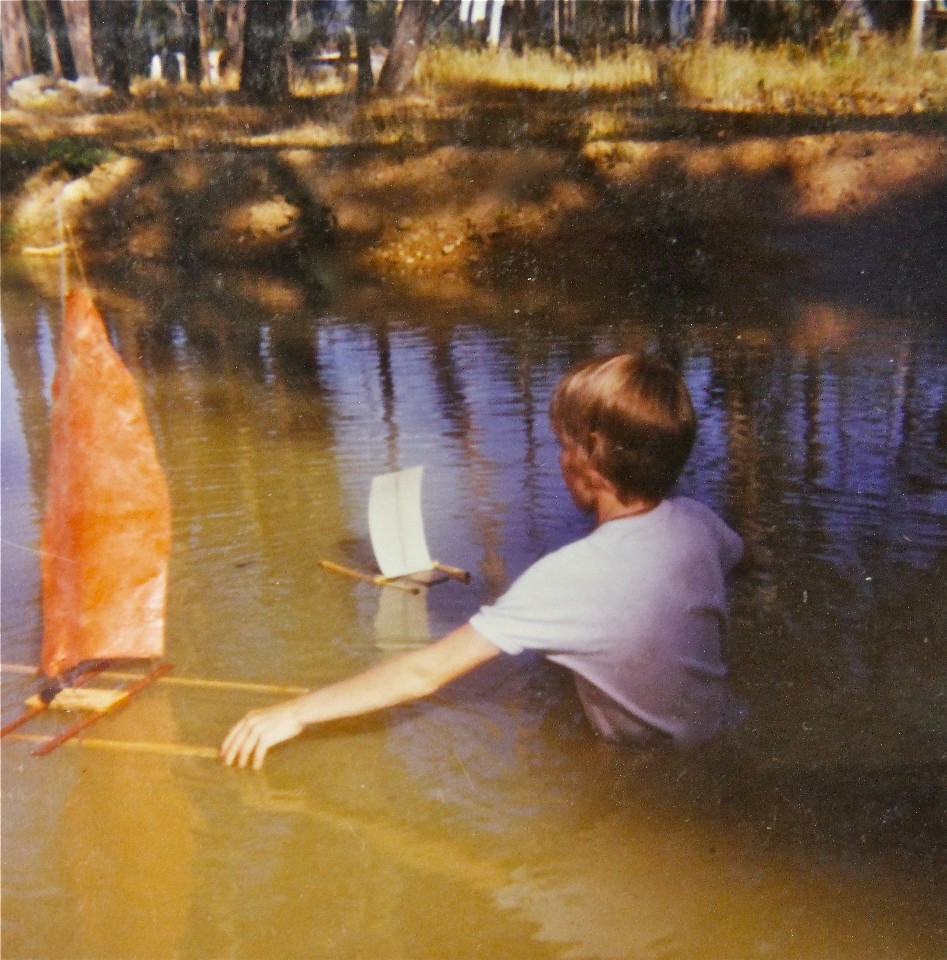
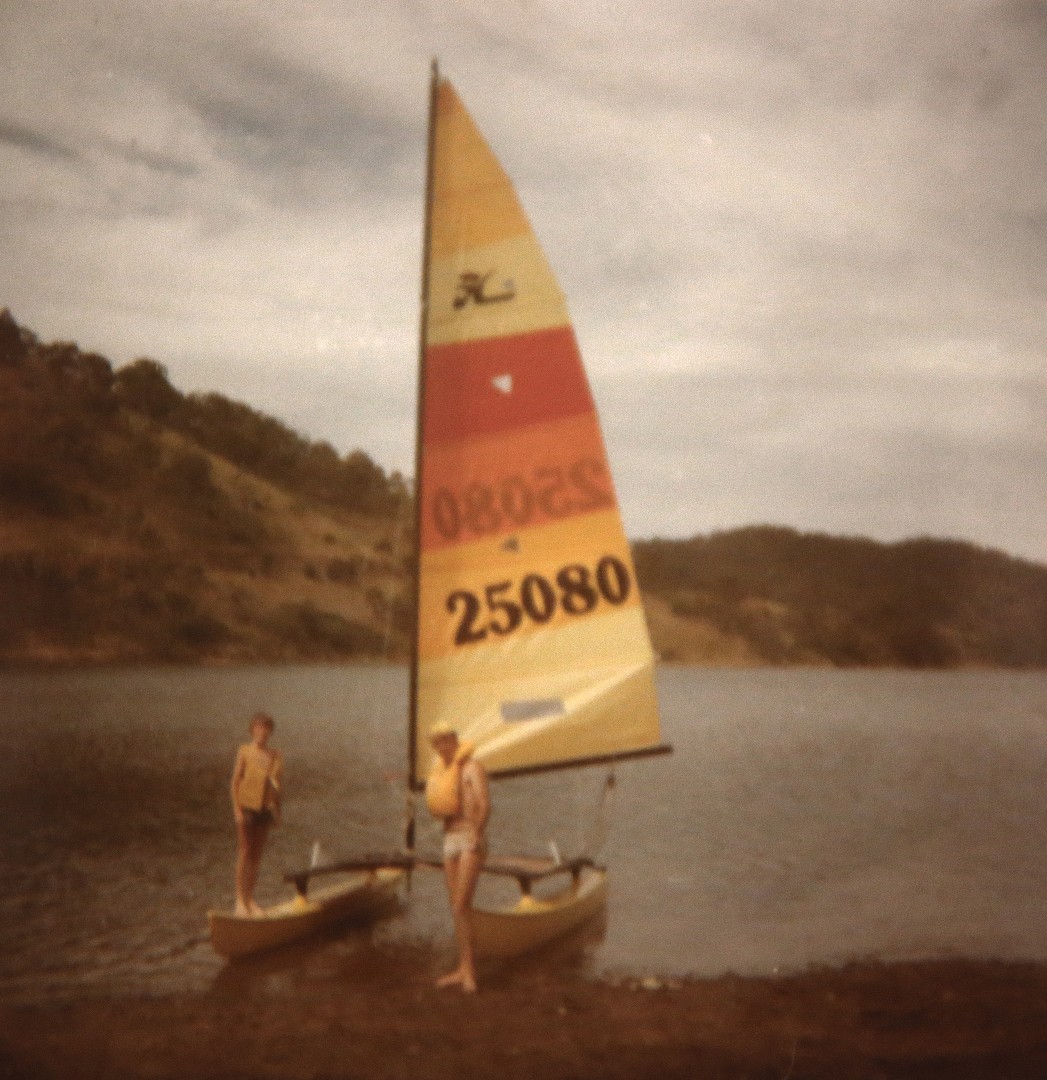
The Larsen formative years
So how did that move to an interest in speed records I enquired. ‘Many forces in my life conspired…!’ was the reply. He continued playing around and making little sailing models on his muddy pond, and mentions he had no real conventional indoctrination as to what a sailing boat should be and how it worked. He wasn’t given a working model, so he played with ideas he tells me. ‘Some of those weren’t too conventional, not back then anyway.’ Later when he got into Hobies and some more serious racing, he found that he just loved the whole drama of the big wind days. ‘They were a bit looser with what they would race in wind-wise back then’ and adds that sailing was a pretty big thing in Australia in the early-mid 80’s. He remembers that he stayed up until the early hours watching every thrilling detail of that 12 meter paint drying in the ground breaking ‘83 cup. ‘I loved the fact that we had an innovative boat in Australia II. A little later I also got to see and race against Victoria 150, the Australian Little America’s Cup C-class cat. I think Chris Cairns and Scott Anderson were sailing on it.’ The next one he saw was The Edge on which Simon Mckeon and Tim Daddo sailed. ‘Funny as they/we all now sail A-cats! Those C-cats blew me away!’. Later Simon and Tim drove Yellow Pages to a 46.52 knot speed record that stood for 11 years. ‘Now that was a cool boat’ Paul says, ‘Super efficient. I guess I saw outright speed sailing as a pure representation of what works and what doesn’t with respect to wind and water.’
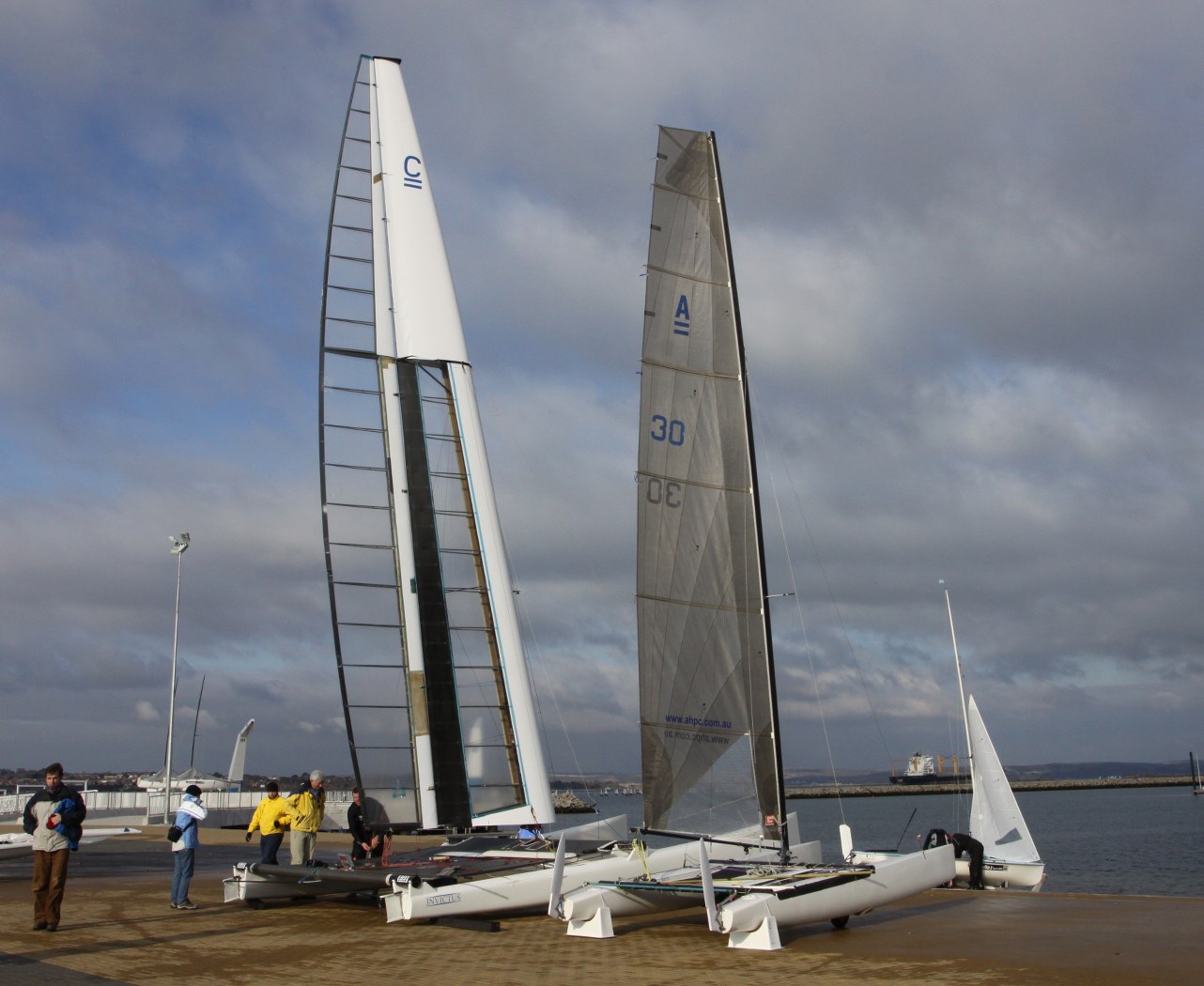
The C Class and the A Class. Weymouth Speed Week.
Paul admits that of course there was a healthy dose of youthful ego thrown into the pursuit at the start of Sailrocket. ‘It’s also a logical progression for wanting to go faster. I think the motives changed throughout the project. In the end I felt a strong responsibility to everyone I’d brought down the path… including myself to finish it. Get the job done right.’ He knew he’d started something and gone looking for support, and it had been offered. ‘I guess I felt I’d effectively asked people to back me to chase a personal dream. In reality they had backed the team… but that’s how I felt.’ He didn’t take the responsibility lightly, adding ‘I owed them my best. I wanted everyone to be part of something special. In my mind it was only going to end one way and I couldn’t imagine living a life explaining why we didn’t get there.’
The funny thing is that he always actually wanted to be a fighter pilot as many of us do. However, his life directed him towards the water instead of the air. ‘I loved the Chuck Yeager story and others from that crazy “try-anything” era!’ In fact Sailrocket 2 was painted orange as a sort of homage to the Bell X-1 Yeager broke the sound barrier in. ‘We went to our own remote desert’ he added, ‘and broke other barriers. In that respect I got to sit in the hot seat and thus lived out more than one dream.’
I asked when he first started being interested in the ‘A’ Class cat. ‘Well they grabbed my attention from the moment I saw them!’ adding that ‘Our fleets didn’t mix that often, so they always seemed a little exotic. They always looked so graceful.’ As a kid racing when Hobies, he couldn’t wait to get out on the trapeze, but remembers seeing the guys on the A’s be out on the wire way before they were on the Hobie 16s. ‘You’d just sit there watching them glide away higher and faster on smooth water, yeah nice!’ He only ever got one much later when he got involved with the Invictus C-cat program here in the UK. ‘Those boats can spend forever in sheds’ he says, ‘So I wanted to get a boat to keep me sharp… and try a few things out on.’ He bought a Bim in 2007 and proceeded to learn about what was involved with canting its rig. ‘It was a pretty cool little boat, which I greatly enjoyed.’
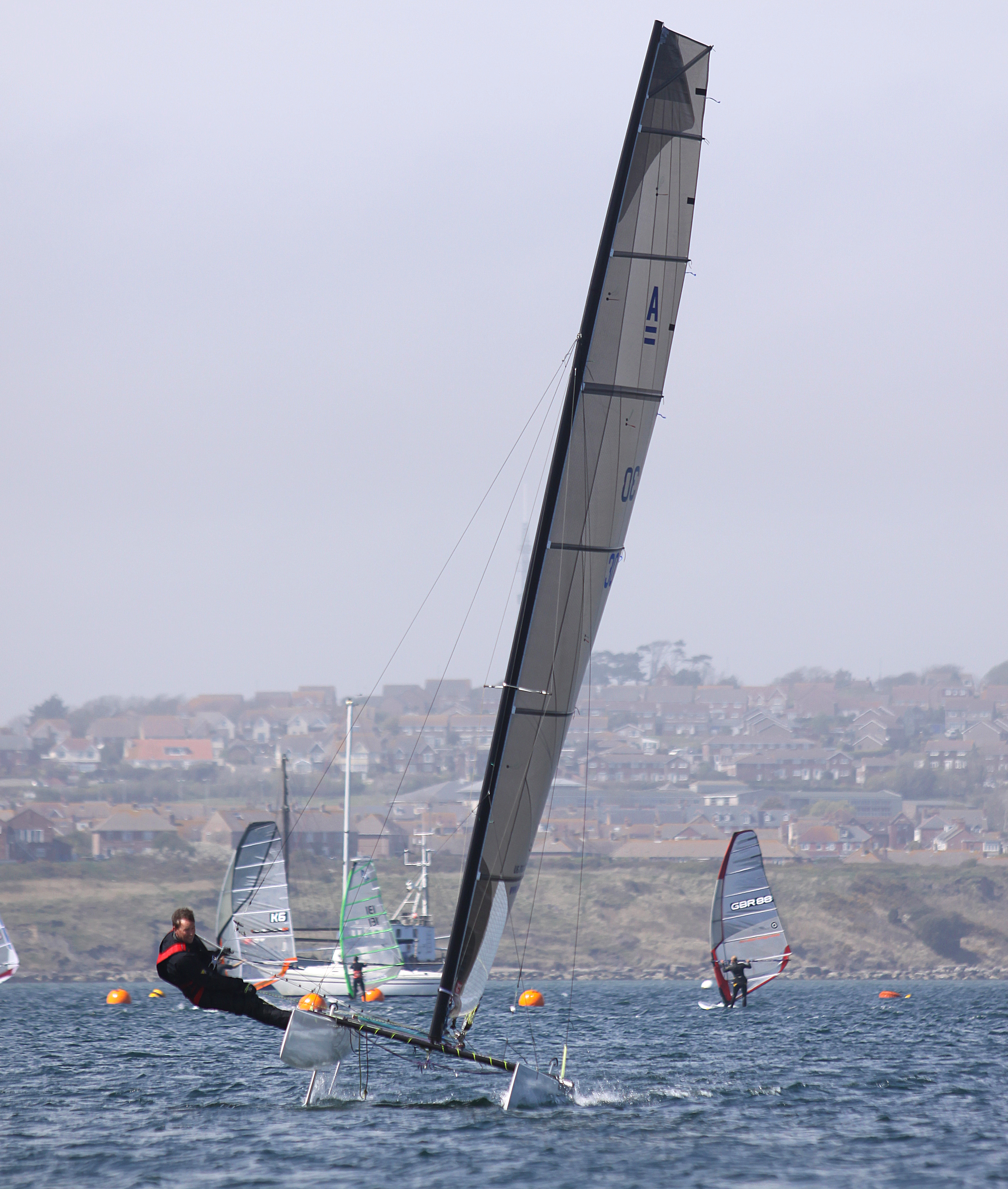
Paul's Bim with his canting rig
Interested in what appeals most about the ‘A’ cat, he tells me that it was the grace and efficiency. But on the other hand he liked the “thrashability” of the tougher beach cats. Whilst the sailing techniques were changing and the class was evolving i.e. wild-thing, curved boards, T-rudders, he knew the fact remained that, elsewhere, bigger leaps were being taken. ‘You couldn’t ignore the Moth class, they forced you to ask yourself why should you stick with a catamaran?’ He tells of how he was given a chance, by a good friend in Abu Dhabi, John Downey, to sail his A-cat fitted with a set of Dario Valenzas J-foils. ‘It took me a while to find my feet but when that thing began to lift-off, just fell for it! I couldn’t stop thinking about it all night. What if I do this? Why does it do that etc.?’ He recalls of how he couldn’t wait to get down to the club and go sailing again. ‘A whole new world had opened up. I hadn’t felt that simple youthful enthusiasm for going sailing for a long time. It was the sensation of flying combined with sailing that had me mesmerized. Yeah foiling was the clincher and I knew I would want more of it when I returned to the UK.’
Paul began shopping for a foiling solution. He looked at all options but ended up driving to the Punta Ala worlds in 2015 with an empty trailer and spending way more than he originally intended. ‘I’m glad I did!’ he says. ‘The Exploders just represented such good value that the answer presented itself.’ He bought a new A-15 ex-worlds, but didn’t spend a lot on a new sail as it was obvious after Punta Ala that the deck-sweeper was coming. He thinks Punta Ala was a great event. ‘The racing was great, the venue was great and the class looked vibrant. I liked the fact that the class was taking on foiling. It’s a development class after all and this means there was likely be some low hanging fruit design-wise that could be easily reached.’ He likes the design aspects and thinks the choice to go foiling should mean that every design aspect of the A-class, within the rules, should be re-considered. ‘I still think we’ll see some pretty interesting stuff come out. Now, a few years on, I’m pretty convinced the class had to go foiling to stay relevant to a new audience.’
I then wondered what aspects of sailing the Team Concise MOD 70 had in common with the ‘A’ cat. ‘Not much really’ he replies, ‘but that said, I feel that sailing the A-cat improves my helming on the MOD… more so than vice versa.’ Paul knows that pushing the ‘A’ as hard as it can go can be pretty intense in a breeze. ‘It’s totally mentally engaging. The MOD can also obviously get very intimidating when things get full-on. Thrashing the ‘A’ sharpens your focus and confidence to push hard. The more time you spend riding on “the edge”, the more comfortable you become in being there.’ Of course, the fast stuff is only part of the picture. You need to know what to do in the slow stuff as well. ‘I think any dinghy sailing offers great bang-for-buck in this respect. You get to try stuff out on your own and have its merits judged on a race track against others.’ But also comments that getting just two MOD’s together at any one time is proving hard work. Often he does draw on his experience elsewhere in sailing to set them up.
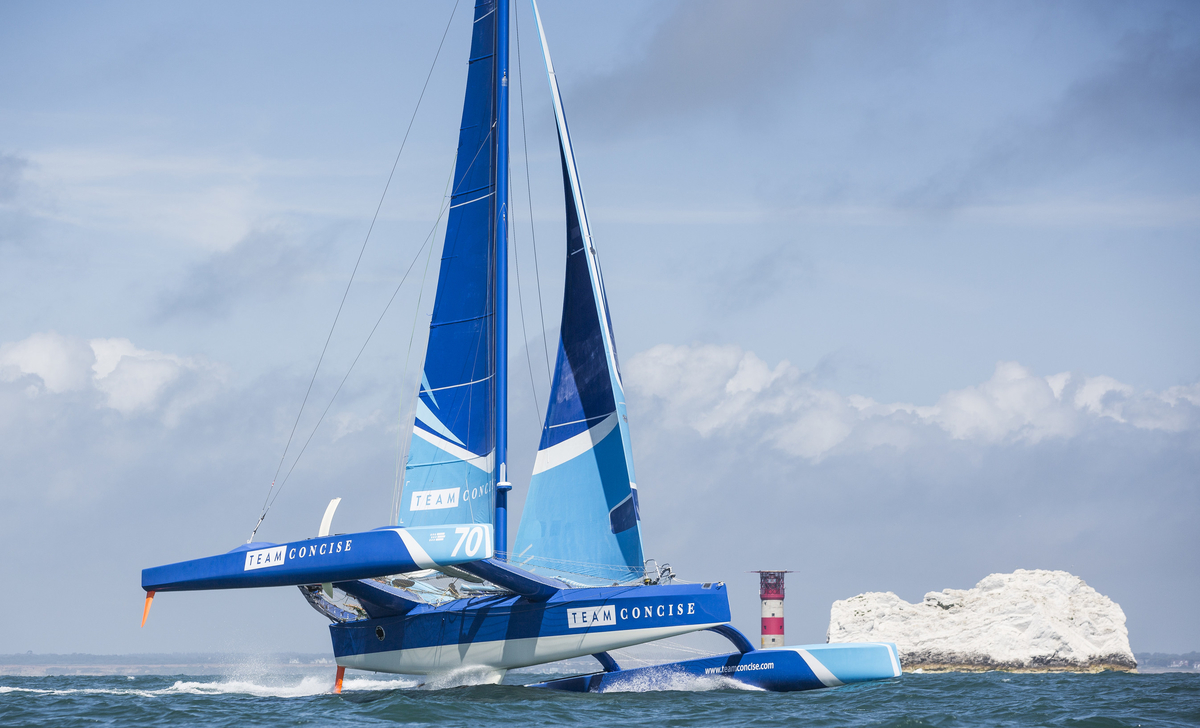
The Team Concise MOD 70 rounds the Needles
‘They are both fantastic boats with specific skill sets. You could get any decent A-cat helm to drive a MOD pretty damned fast but you couldn’t necessarily do the reverse as quickly’ he said. ‘Also, there is a lot more to racing a MOD than just pushing the stick. I’ve loved having both in my life.’
I enquired as to if he thought that the designs have now reached a practical level for most competent sailors as regards foiling. Pauls reply was somewhat non-committal. ‘Yes…. Hmmmm… and maybe’ he says. ‘It’s challenging and that is part of the reason I like it so much.’ Of course any competent sailor can go out and go for a good foiling blast on an ‘A’. You’ll have great fun and with practice, get around a course in good shape. He thinks that in most conditions they are simply great fun boats that respect finesse like any other boat. They are fun boats just to train on and the training is very rewarding. ‘You can make big gains trying new tricks. I think it’s getting interesting again now as upwind foiling begins to become a real “thing” around the course’ and adds ‘It’s hard work and, due to the limited control we have over the non-active foils, it can get pretty loose.’ It’s a logical progression for the class. He was out training against Chris Rashley a week or so ago and Chris was reliably foiling upwind in around 11 knots. ‘It isn’t the quickest way to the top mark until the wind gets stronger, but the fact is he’s doing it.’ It’s a mode in the armory. And what happens if this mode is really only accessible to a few? ‘We’ll see,’ Paul says, ‘maybe the boat design will adapt within the existing rules as people try and make it more accessible. Certainly a lot of it has to do with current rig design.’ But he also thinks that as many more people start to take on upwind foiling, we’re going to see some real madness at the windward marks on windy days with bigger fleets, so care will be needed.
He likes to watch how other new designs are developing and what they are offering. When you look at fully active designs like the Stunt, Whisper or i-fly, he also wonders what lies down the path if you end up racing those concepts hard. He asks what corners the racers will push them into. ‘When you start adding the righting moment potential of active foils pulling down to windward, the potential exists to have a highly loaded, crazy quick small boat. I know. I’ll be interested to see how those concepts develop. Let’s face it, if it was just speed we were after, we’d be wise to ditch all these clunky boats and get foiling kite boards. There’s more to it than just who’s fastest!’ he says with just a hint of irony.
‘For now, I love the balance of compromises the A-class currently offers’ he continues. ‘Many elements of the original boat are still mixed in there and combined with the high speed thrills that come with foiling.’ As multiple ‘A’ Cat World Champ, Glenn Ashby, explained it to him when he was shopping in Punta Ala, - it’s a great mix of old school and new school. ‘My point with respect to the question is there are some new tricks being discovered in the new school and they are challenging. But hey, it’s a development class, so let’s see what happens. I’m sure developing!’ he adds with a grin.
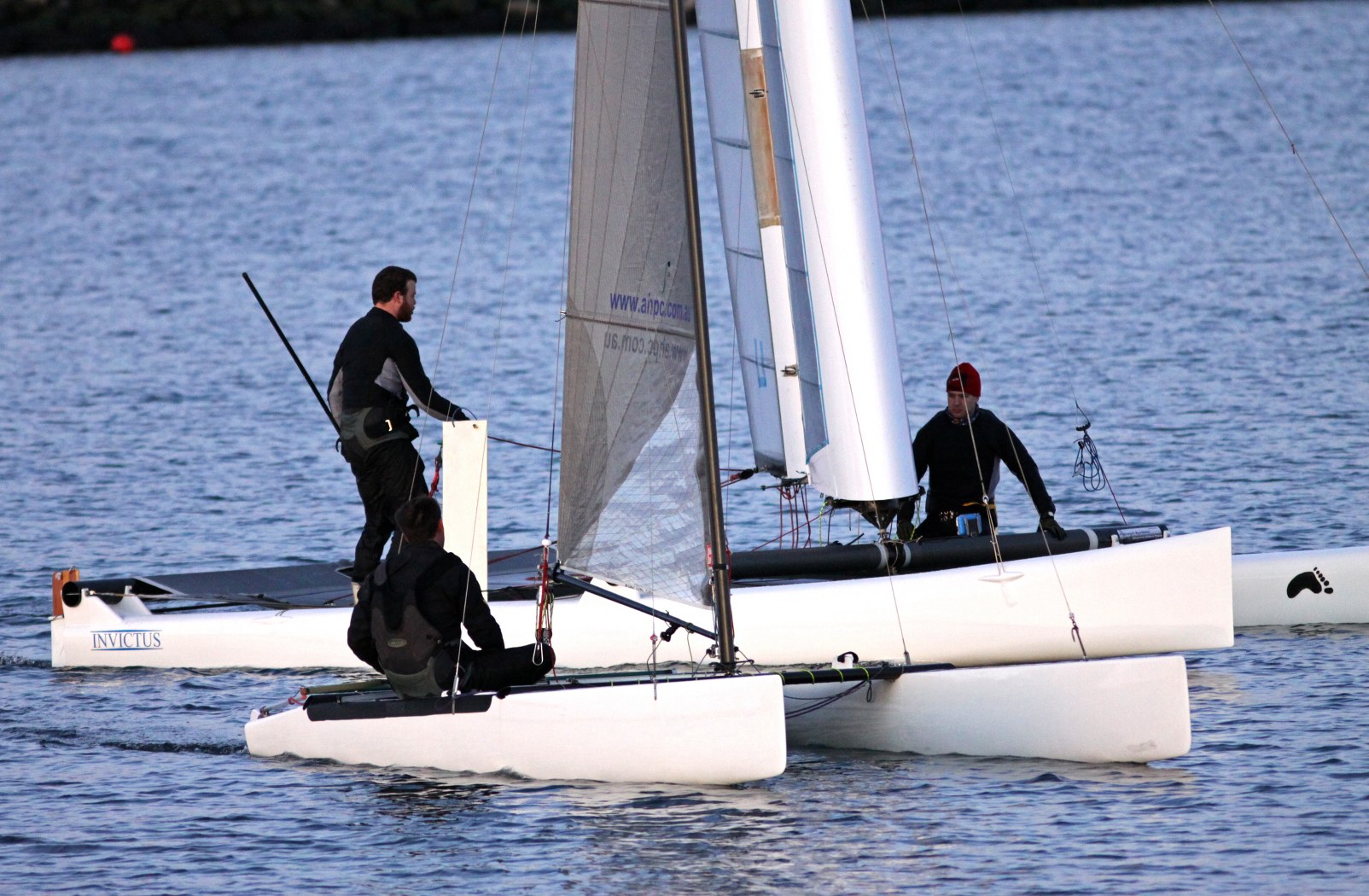
The Invictus C Class and the Bimare 2000 A Class
I asked Paul about how he personally saw the class developing over the next couple of years. ‘One thing is for sure, to be fast, you’re going to have to aim to spend more time up than down. This should, ideally, lead to refinements that make it all more accessible. If not, then maybe there’s a problem.’ He thinks the foil control is going to become more refined. At the moment it’s pretty crude, especially with respect to the rudders. He also thinks we’ll will see significant development in the rigs. ‘I think there’s big gains to be made there’ he says with a twinkle in the eye. The good thing, as he points out, is that some of these things can be retro-fitted and often they will simply make the boat nicer to sail for all. The boards seem to be getting moved forwards all the time and it makes him wonder how far this can be pushed. ‘I simply hope we keep seeing innovators in the class. Especially those who follow through with their concepts and implement them well.’ He thinks some of the results of innovation are unexpected i.e. two “wrongs” can sometimes combine to make a “right”. ‘I see this all the time when trying to come up with solutions for our next Sailrocket’ he adds. ‘In fact, the whole nature of that boat has changed due to accidental discoveries along the way. Design dead ends re-open when combined later with new concepts.’
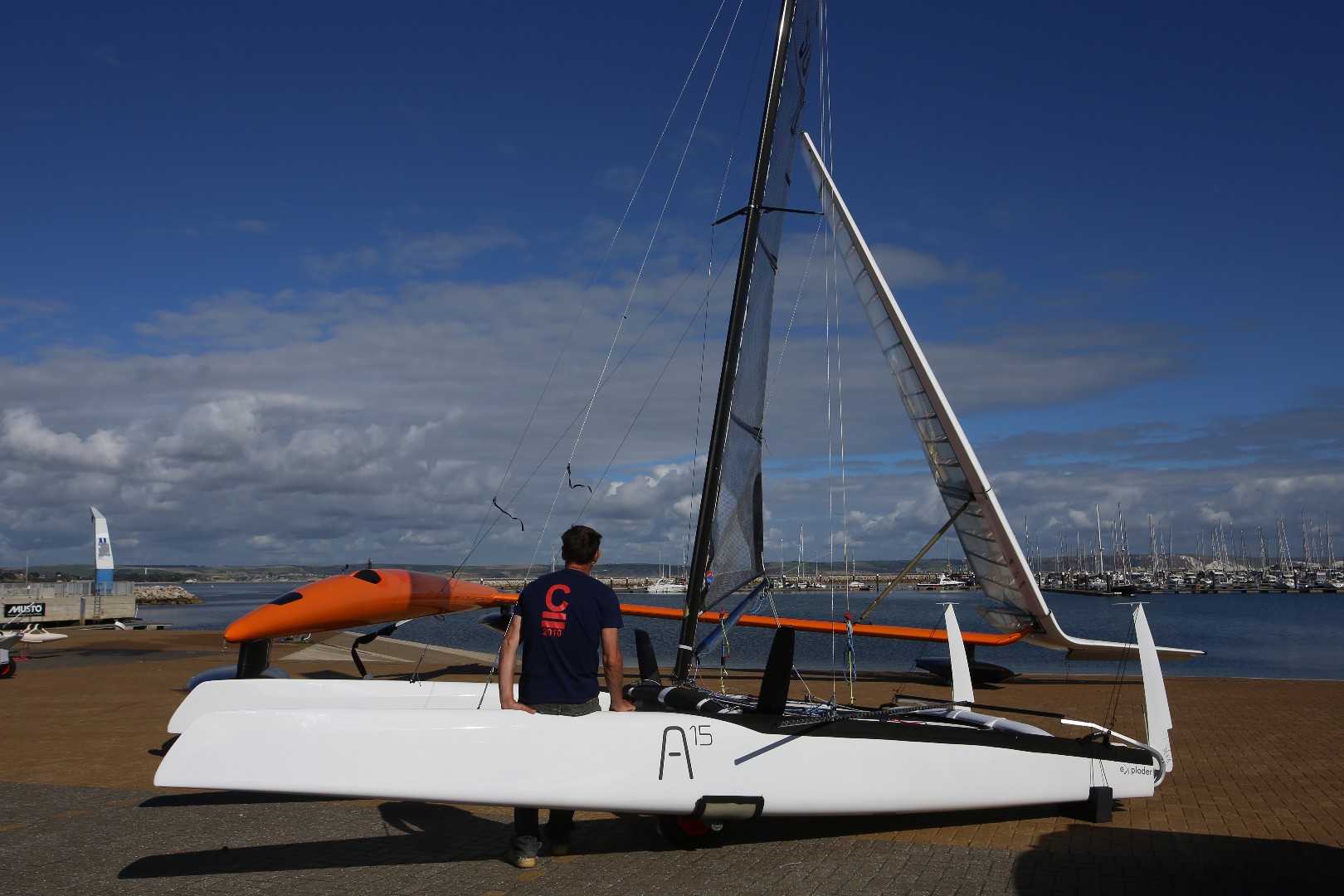
The World Record Breaking Sailrocket II behind Paul and his Exploder A15
And finally I wanted to know if anything the ‘A’ class as a whole could learn from his Sailrocket experiences. ‘Sailrocket smashed the record’ he says, ‘and for the most amount of work and the least amount of sailing for any successful project in sailings history. SR2 sailed for maybe an hour… definitely not two. Don’t overcomplicate your sailing!’
Another aspect to consider, he points out, is that the Sailrocket project was ultimately a big science experiment with no other purpose than to prove a point. It did that partly by taking the whole balancing act away from the humans. The concept was dynamically stable. ‘There’s only one other boat that made production that could share the same claim and that was the Hobie tri-foiler’ he says. ‘Great concept, but they never really got raced either. I’m not sure taking some of the fun and challenging bits away from your toy is… well…fun. It’s bloody quick, but as the second hand jet-ski market testifies, that’s only good for a while.’
He often wonders what it is that should define an A-cat beyond just the basic rules. What’s the “vibe”. And thinks it should remain relatively quick, simple and effortless for one person to go down to the water, rig and launch. To have a real “current” and classy performance multihull to sail on and put away within a short time frame. Anything that compromises this Paul says, should be questioned. ‘There’s aspects of wing rigs I love… but not on my own daily ride. The elegant, simplicity of owning and sailing an A-class needs to be defended.’ He knows that part of the fun of the racing is the fleet. That’s what he enjoyed about Punta Ala. He feels that fleet would have eventually diminished if foiling hadn’t had been embraced and in that respect he thinks the class has done a great job so far. ‘Sure, it does add some complexity, but it brings a lot too.’
He mentioned that on a technical side, all of modern foiling sailing is headed Sailrockets way. The apparent wind keeps moving forward and getting stronger. He commented that this forces people to focus on increasing their crafts lateral stability to control heeling forces. ‘Bigger guys with lower center of efforts. Deck-sweepers, better twist control etc.’ And he finishes by saying ‘The Sailrocket program simply followed that path to it’s ultimate conclusion!’ Long may it continue.
Many thanks go to Paul for giving us this insight!
Photos - Paul Larsen, Sailrocket, Team Concise, Gordon Upton,








